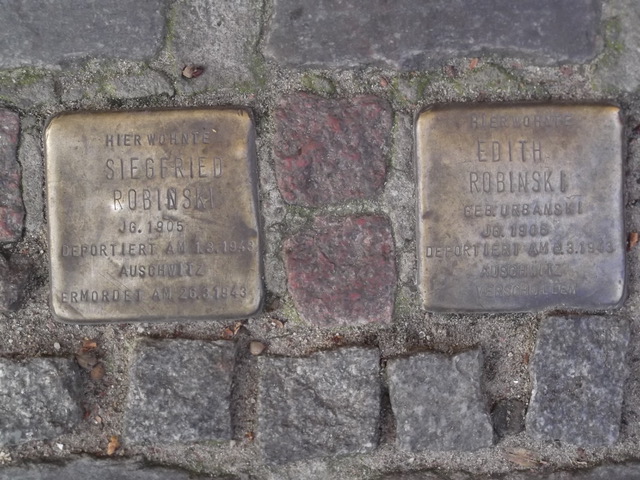Berlin to South Africa: Letters of Stones
Some readers of my recent article, ‘Auschwitz to Rwanda: the link between science, colonialism and genocide’ will be interested to learn more about the harrowing connections between colonial science, African and European mass atrocities. An excellent starting point for this is a reading of Steven Robins’ Letters of Stone. From Nazi Germany to South Africa (Cape Town: Penguin Books; 2016).
The book’s title speaks to the weight carried by the holocaust survivors, who were driven into silence, as well as their descendants. It also references the ‘stumbling stones’, small brass plaques set in pavements, which have over the past decade-and-a-half in Germany become emblematic of commemorating those who perished through the Nazi atrocities of the 1940s.
This form of commemoration in the everyday started in 1996 with a temporary installation by artist Gunter Demnig on Oranienstrasse in Berlin-Kreuzberg. Four years later Robins visited Berlin from Cape Town in his quest to learn more about the fate of his father’s family. Working with the local community museum and Demnig, the South African anthropologist became the first to plant permanent stumbling stones in Berlin in memory of his relatives at 46 Naunynstrasse, just off Oranienplatz.

Letters of Stone recounts this project. The book is more though than a family’s tragic history. When Robins delivered his inaugural lecture as a Professor of Social Anthropology at Stellenbosch University near Cape Town some years after his visit to Berlin, he related his motivation for a career in anthropology to his biography and family background. The book charts his journey of discovery about the lives and fates of his father’s family in southern Africa, Berlin, Riga and Auschwitz. The biographical narrative is intertwined with the wider context of early and mid-twentieth century South Africa on the one hand, and, on the other, the history of the holocaust and of international, and especially German, physical anthropology, eugenics and race science.
Steven Robins was raised in the 1960s and 1970s in the South African industrial seaport town of Port Elizabeth in what he describes as a “thoroughly anglicised secular Jewish home” (p. 5). Their surname, Robins, was English, although his father’s family in Germany had retained the name Robinski. In the family’s dining room stood a black-and-white photograph of three unknown women in old-fashioned formal clothing. Only later did Steven learn that they were his grandmother and aunts, and that they were murdered in the Holocaust. His father, who had managed to escape to South Africa from Nazi Germany in 1937, never spoke of the fate of his family who had remained trapped in Berlin when South Africa and many other countries closed their doors to Jewish refugees.
With this photograph opens the poignant story of how Steven gradually discovered his family’s fate. Telling his journey from the meagre official facts he initially stumbled upon in museums in Washington and Berlin, the story unfolds powerfully after he later discovered a set of letters sent from the family in Berlin to his father and only surviving brother in southern Africa. Through these letters the mute women in the dining-room photograph could now tell their own story.
Steven Robins does not only convey his own and his family’s harrowing history. He powerfully connects it with the rise of racial science and eugenics worldwide, and especially in Germany, which justified the racist murder of the European Jews, Sinti and Roma. He especially explores the southern African origins of the ‘scientific’ study of heredity in human evolution, conducted in 1908 by the physical anthropologist Eugen Fischer. As I discussed in ‘Auschwitz to Rwanda’, Fischer’s study focused on the effects of racial mixing (‘miscegenation’), for which he examined the Basters of Rehoboth in the then German colony of South West Africa.
Robins demonstrates that scientists like Fischer, driven by unbridled ambition, became instrumental for the persecution of all those that the Nazis considered undesirables. The ‘Kaiser-Wilhelm Institute for Anthropology, Human Heredity and Eugenics’ (KWI-A), housed in Berlin-Dahlem, whose first Director Fischer had become in 1927, played a prominent role in the Nazi racist ideology and policy. The scientists’ lethal complicity in the holocaust became even more pronounced under Otmar von Verschuer, who succeeded Fischer as Director from 1942. Robins’ pronouncement that “through Fischer’s work, a barbaric and lethal science incubated in the colonial laboratories of southern Africa had boomeranged back into the heartland of ‘civilised Europe’” (p. 131), indicates the striking similarities in the ways Fischer and colonial officials classified Rehoboth Basters at the beginning of the 20th century, and the Nazis’ classification of the European Jews. Robins’ observation is indeed powerfully reminiscent of the writings of Hannah Arendt and Aimé Césaire, who have pointed out the colonial origins of the dehumanisation and objectification of racially and eugenically undesirables by the Nazis.
This is a significant book, deeply moving, a multi-layered presentation of autobiography, photography, the family letters, which brings back the voices of some who perished in the Holocaust and breaks the silence of survivors like Steven’s father.
It is also a layered excavation of the inextricable connections between Germany, Namibia and South Africa. In the end, Robins traces the roots of racial science back to South Africa and Stellenbosch University where he teaches and demonstrates the intersected challenges in today’s world, reminding his readers of 21st century people fleeing from theatres of war and violence and their tormenting attempts to find refuge.